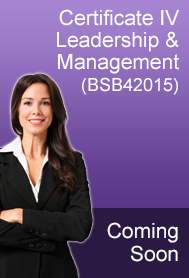|
|
|
This qualification reflects the roles of experienced practitioners delivering training and assessment services usually within Registered Training Organisations (RTOs) within the vocational education and training (VET) sector. They may have a role in leading other trainers and assessors and in providing mentoring or advice to new trainers or assessors as well as designing approaches to learning and assessment strategies across a significant area within the RTO.

The TAE50111 qualification requires completion of ten (10) units of competency, comprising six (6) core units and four (4) elective units.
The Core Units that all RPL applicants MUST be able to evidence and demonstrate competency in are:
- TAEASS501A - Provide advanced assessment practice
- TAEASS502B - Design and develop assessment tools
- TAEDEL502A - Provide advanced facilitation practice
- TAEDES501A - Design and develop learning strategies
- TAELLN411 / TAELLN401A - Address adult language, literacy & numeracy skills
- TAEPDD501A - Maintain and enhance professional practice
In packaging your qualification for RPL purposes, the remaining four (4) Elective Units:
- Must include at least two (2) units from the Listed Elective Units in the TAE50111 Packaging Rules (as detailed below); and
- May include two (2) units from any currently endorsed Training Package or VET Accredited Course, being units from a qualification or course at Diploma level or above.
Download full details here.

To successfully pursue this Recognition of Prior Learning (RPL) Assessment Only pathway, you MUST:
- Confirm your eligibility per the RPL Eligibility Statement provided by ELMO Learning;
- Have your eligibility to pursue an RPL Pathway verified and confirmed by an ELMO Learning Assessor;
- Submit a comprehensive Portfolio of quality evidence to demonstrate competency in all units of competency selected to comprise your qualification;
- Provide sufficient, valid, current, authentic evidence of the type and quantity specified, addressing all evidence requirements of each unit of competency comprising the qualification;
- Provide quality evidence for the correct number and composition of Core and Elective Units comprising the qualification (i.e. submit a Portfolio of Evidence for a selection of units of competency that meet the requirements of the Qualification Packaging Rules);
- Have access to a fully-functional computer / smart device loaded with a web browser (e.g. Internet Explorer, Firefox) and appropriate software applications to read PDF files (e.g. Adobe), produce documents (e.g. Microsoft Word, PowerPoint), and analyse information and data (e.g. Excel); and
- Have access to a computer / smart device with reliable Internet Access; and
- Have a camera on your internet-enabled device; and
- Have a Skype account; and
- Have a current valid email account for online communication and support; and
- Have a telephone and current valid telephone number for communication, support and interviews.
You will need:
- Language skills at a level that enables you to: consult, collaborate, cooperate and negotiate with a range of individuals and groups (including learners, peers, clients, organisational representatives) on a range of issues, tasks and projects; participate in and lead discussions; elicit information (e.g. client requirements, learner characteristics and needs); deliver engaging presentations and facilitate training sessions with a range of audiences (both group and individual) in a variety of contexts; conduct assessment; provide clear explanations, options and advice; give clear and precise instructions; provide and seek constructive feedback; build rapport, establish effective working relationships and communicate in a culturally appropriate manner with a range of people from diverse backgrounds and with diverse abilities; share information; engage and motivate learners;
- Literacy skills at a level that enables you to: read, interpret, understand and use a range of complex written information and text (including learning programs and plans, assessment plans, enrolment records, pre-training assessments, learning theories, instructional design principles, legislation, organisational policies and procedures, Training Package components, VET Accredited Course information, Australian Core Skills Framework, VET Quality Framework, workplace documentation, and technical standards); develop, complete and maintain documentation (including training and assessment materials [e.g. programs, plans, resources, tools, records]); develop and organise learning content; and produce a range of documents in a variety of formats (e.g. training and assessment records, reports, presentations, learning and assessment plans) for a range of audiences and contexts;
- Numeracy skills at a level that enables you to: interpret and compare numerical information and data, including measurements; allocate, monitor and evaluate timeframes (e.g. time allocations in learning programs); and work with technical workplace information (e.g. equipment specifications, productivity standards, performance specifications);
- Technology skills at a level that enables you to: conduct online research using a web browser (e.g. Internet Explorer, Firefox); operate equipment; and use a variety of software applications and tools to read files (e.g. Adobe), produce documents (e.g. Microsoft Word, PowerPoint), analyse information and data (e.g. Excel), complete work tasks, design work processes, and communicate effectively with others; and
- Research skills at a level that enables you to: access, analyse and use a range of resources for training and assessment purposes (including Units of Competency, assessment tools, training and assessment materials, and policies and procedures (e.g. RPL, assessment)); determine and analyse learner characteristics and needs; and analyse and interpret Training Package and VET Accredited Course content to meet client needs.






